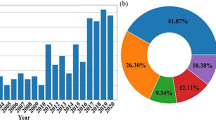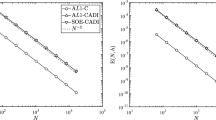Abstract
A singularly perturbed reaction–diffusion problem posed on the unit square in \(\mathbb {R}^2\) is considered. To solve this problem numerically, a finite volume method (FVM) whose primal mesh is Shishkin is constructed; the FVM solution is piecewise bilinear on this mesh. Working in the standard energy norm, a superclose result (for the difference between the FVM solution and the Lagrange interpolant of the exact solution) is derived. This result yields an improved bound for the \(L^2\) error of the FVM solution, and implies that a simple postprocessing of the FVM solution produces (in the energy norm) a higher-order approximation of the true solution. Next, we analyse errors in a balanced norm that is stronger than the energy norm; using a more complicated approximant of the exact solution from our piecewise bilinear space, we prove an optimal-order error bound and an associated supercloseness result showing that the difference between the FVM solution and our approximant is of higher order than the error itself. Finally, numerical experiments demonstrate the sharpness of our error bounds.

Similar content being viewed by others
Data Availability Statement
Not applicable.
References
Cao, W., Zhang, Z., Zou, Q.: Finite volume superconvergence approximation for one-dimensional singularly perturbed problems. J. Comput. Math. 31(5), 488–508 (2013). https://doi.org/10.4208/jcm.1304-m4280
Eymard, R., Gallouët, T., Herbin, R.: Finite volume methods. In: Ciarlet, P.G., Lions, J.L. (eds.) Handbook of numerical analysis, Handb. Numer. Anal., vol. VII, pp 713–1020. North-Holland, Amsterdam (2000). https://doi.org/10.1016/S1570-8659(00)07005-8
Farrell, P.A., Hegarty, A.F., Miller, J.J.H., O’Riordan, E., Shishkin, G.I.: Robust Computational Techniques for Boundary Layers, Applied Mathematics (Boca Raton), vol. 16. Chapman & Hall/CRC, Boca Raton (2000)
Heuer, N., Karkulik, M.: A robust DPG method for singularly perturbed reaction–diffusion problems. SIAM J. Numer. Anal. 55(3), 1218–1242 (2017). https://doi.org/10.1137/15M1041304
Li, R., Chen, Z., Wu, W.: Generalized Difference Methods for Differential Equations, Monographs and Textbooks in Pure and Applied Mathematics, vol. 226. Marcel Dekker Inc, New York (2000). (Numerical analysis of finite volume methods)
Lin, R., Stynes, M.: A balanced finite element method for singularly perturbed reaction–diffusion problems. SIAM J. Numer. Anal. 50(5), 2729–2743 (2012). https://doi.org/10.1137/110837784
Linß, T.: Layer-adapted Meshes for Reaction–Convection–Diffusion Problems, Lecture Notes in Mathematics, vol. 1985. Springer, Berlin (2010). https://doi.org/10.1007/978-3-642-05134-0
Liu, F., Madden, N., Stynes, M., Zhou, A.: A two-scale sparse grid method for a singularly perturbed reaction-diffusion problem in two dimensions. IMA J. Numer. Anal. 29(4), 986–1007 (2009). https://doi.org/10.1093/imanum/drn048
Madden, N., Stynes, M.: A weighted and balanced FEM for singularly perturbed reaction–diffusion problems. Calcolo 58(2), 28 (2021). https://doi.org/10.1007/s10092-021-00421-w
Roos, H.G., Schopf, M.: Convergence and stability in balanced norms of finite element methods on Shishkin meshes for reaction–diffusion problems. ZAMM Z. Angew. Math. Mech. 95(6), 551–565 (2015). https://doi.org/10.1002/zamm.201300226
Roos, H.G., Stynes, M., Tobiska, L.: Robust Numerical Methods for Singularly Perturbed Differential Equations, Springer Series in Computational Mathematics, vol. 24, 2nd edn. Springer, Berlin (2008). (Convection-diffusion-reaction and flow problems)
Stynes, M., Stynes, D.: Convection–Diffusion Problems, Graduate Studies in Mathematics, vol. 196. American Mathematical Society, Atlantic Association for Research in the Mathematical Sciences (AARMS), Providence (2018). https://doi.org/10.1090/gsm/196 . (An introduction to their analysis and numerical solution)
Stynes, M., Tobiska, L.: The SDFEM for a convection–diffusion problem with a boundary layer: optimal error analysis and enhancement of accuracy. SIAM J. Numer. Anal. 41(5), 1620–1642 (2003). https://doi.org/10.1137/S0036142902404728
Toro, E.F.: Riemann Solvers and Numerical Methods for Fluid Dynamics, 3rd edn. Springer, Berlin (2009). https://doi.org/10.1007/b79761 . (A practical introduction)
Varah, J.M.: A lower bound for the smallest singular value of a matrix. Linear Algebra Appl. 11, 3–5 (1975). https://doi.org/10.1016/0024-3795(75)90112-3
Wang, Y., Meng, X., Li, Y.: The finite volume element method on the Shishkin mesh for a singularly perturbed reaction–diffusion problem. Comput. Math. Appl. 84, 112–127 (2021). https://doi.org/10.1016/j.camwa.2020.12.011
Wang, Y., Meng, X., Li, Y.: The Bogner–Fox–Schmit element finite volume methods on the Shishkin mesh for fourth-order singularly perturbed elliptic problems. J. Sci. Comput. 93(1), 4 (2022). https://doi.org/10.1007/s10915-022-01969-7
Zhang, J., Liu, X.: Supercloseness in a balanced norm of finite element methods on Shishkin and Bakhvalov–Shishkin rectangular meshes for reaction-diffusion problems. Math. Methods Appl. Sci. 45(4), 2204–2218 (2022). https://doi.org/10.1002/mma.7920
Zhang, Z., Zou, Q.: Vertex-centered finite volume schemes of any order over quadrilateral meshes for elliptic boundary value problems. Numer. Math. 130(2), 363–393 (2015). https://doi.org/10.1007/s00211-014-0664-7
Zhu, G., Chen, S.: Convergence and superconvergence analysis of finite element methods on graded meshes for singularly and semisingularly perturbed reaction–diffusion problems. J. Comput. Appl. Math. 220(1–2), 373–393 (2008). https://doi.org/10.1016/j.cam.2007.08.025
Zhu, G., Chen, S.: Convergence and superconvergence analysis of an anisotropic nonconforming finite element methods for singularly perturbed reaction–diffusion problems. J. Comput. Appl. Math. 234(10), 3048–3063 (2010). https://doi.org/10.1016/j.cam.2010.04.021
Acknowledgements
None.
Funding
The research of Xiangyun Meng is supported by the National Natural Science Foundation of China under Grants 12101039. The research of Martin Stynes is supported in part by the National Natural Science Foundation of China under Grants 12171025 and NSAF-U2230402.
Author information
Authors and Affiliations
Contributions
MS designed the study, performed the research and wrote the manuscript; XM designed the study, performed the research and wrote the manuscript.
Corresponding author
Ethics declarations
Conflict of interest
The authors declare that they have no conflict of interest.
Ethics approval
Not applicable.
Additional information
Publisher's Note
Springer Nature remains neutral with regard to jurisdictional claims in published maps and institutional affiliations.
The research of Xiangyun Meng is supported by the National Natural Science Foundation of China under Grant 12101039. The research of Martin Stynes is supported in part by the National Natural Science Foundation of China under Grants 12171025 and NSAF-U2230402.
Appendix
Appendix
Proof of Lemma 12
Assume that \(b_1(x)\ge \beta _1>0\) and \(b_2(y)\ge \beta _2>0\). We first prove an analogous result in 1D, then use this to deduce the result in 2D.
The 1D case: Recall that \({\bar{\varOmega }}_{0,x}\) is divided by a uniform primal mesh. Let \(U_{h,\varOmega _{0,x}}\) be the space of piecewise linear functions defined on this mesh. Let \(\varPi _{h,x}^*\) be the 1D analogue of the projector \(\varPi _{h}^*\) defined in (6); this maps piecewise linears in \(U_{h,\varOmega _{0,x}}\) to piecewise constants on the dual mesh restricted to \({\bar{\varOmega }}_{0,x}\). That is, if \(w_h\in U_{h,\varOmega _{0,x}}\), then \(\varPi _{h,x}^*w_h = w_h(x_i)\) on \([x_{i-1/2},x_{i+1/2}]\) (modified to \([x_{N/4},x_{N/4+1/2}]\) and \([x_{3N/4-1/2},x_{3N/4}]\) at the boundaries of \(\varOmega _{0,x}\)).
For each \(v\in C({\bar{\varOmega }}_{0,x})\), define its weighted projection \(\pi _{h,x} v \in U_{h,\varOmega _{0,x}}\) by
where \(\phi _j\) is the piecewise linear “hat" basis function associated with the mesh point \(x_j\in {\bar{\varOmega }}_{0,x}\). Writing \(\pi _{h,x} v = \sum _{x_i\in {\bar{\varOmega }}_{0,x}} (\pi _{h,x} v)(x_i) \phi _i\), then the above definition becomes
for each \(x_j\in {{\bar{\varOmega }}}_{0,x}\).
We now compute the Gram matrix associated with (50). If \(i = j\), then
where one should delete \(d_{j,l}\) if \(j=N/4\) and delete \(d_{j,r}\) if \(j=3N/4\). If \(i = j-1\), then
If \(i = j+1\), then
For \(i \notin \{j-1,j,j+1\}\) one has \(\langle \phi _i,b_1\varPi _{h,x}^* \phi _j\rangle _{{\bar{\varOmega }}_{0,x}} = 0\). Rescaling, we divide (50) by
This yields the linear system \(Ax = g\) where \(x:= \left( \pi _{h,x} v(x_j):x_j\in {{\bar{\varOmega }}}_{0,x}\right) ^T\) and
Clearly \(\Vert g\Vert _{\infty }\le C\Vert v\Vert _{L^\infty (\varOmega _{0,x})}\).
For \(x_j\in \varOmega _{0,x}\), since \(b_1\ge \beta _1>0\), \(\phi _j>\phi _{j-1}\) on \((x_{j-1/2},x_j)\) and \(\phi _j>\phi _{j+1}\) on \((x_{j},x_{j+1/2})\), a calculation yields \(d_{j,l}-e_{j,l}\ge \beta _1 H/4\) and \(d_{j,r}-e_{j,r}\ge \beta _1 H/4\) (if \(j=N/4\) use only \(d_{j,r}-e_{j,r}\ge \beta _1 H/4\); if \(j = 3N/4\) use only \(d_{j,l}-e_{j,l}\ge \beta _1 H/4\)). Thus the matrix A is strictly diagonally dominant with \(\min _j (|a_{j,j}|-\sum _{i\ne j}|a_{j,i}|) \ge \beta _1/2\), which is independent of H. Hence, by a well-known result [15, Theorem 1], one gets \(\Vert A^{-1}\Vert _{\infty }\le 2/\beta _1\). It follows that there exists a constant \(C_4\) such that
The 2D case: Now we return to the original 2D problem. Write
for some \(\alpha _{i,j}\in \mathbb {R}\). From the definition of \(\pi _h\), for each \((x_i,y_j)\in {\varOmega }_{0}\) one has
where the integrals in this formula are truncated when \((x_i,y_j)\in \partial \varOmega _0\) to avoid integrating outside \(\varOmega _0\). For each j, define averages of v and \(\pi _h v\) by
where we again truncate integrals where necessary: if \(j = N/4\), change \(j-1/2\) to j, and if \(j = 3N/4\), change \(j+1/2\) to j. Then one can interpret (52) as a 1D weighted projection in the x-variable, where \(v_j\) is projected onto \((\pi _h v)_j\). Thus, (51) implies that there exists a constant \(C_5\) such that
where the second inequality is valid because \(0\le \varPi _{h,y}^*\phi _j\le 1\) and \(b_2(y)\) is bounded. But for each j the function
is piecewise linear, with modifications like above for certain j (when \(j = N/4\) change the subscript \(j-1/2\) to j and the sum lower limit \(j-1\) to j; when \(j = 3N/4\) change the subscript \(j+1/2\) to j and the sum upper limit \(j+1\) to j). Thus for \(j = N/4+1,...,3N/4-1\) (modify this argument slightly if \(j=N/4\) or 3N/4) one has
where
satisfy
Choose \((i^*,j^*)\) such that \(|\alpha _{i^*,j^*}| = \max _{(x_i,y_j)\in {{\bar{\varOmega }}}_0}|\alpha _{i,j}|\). Then (53) and (55) give
where we used (56) and the choice of \((i^*,j^*)\). Then we have
as desired. \(\square \)
Rights and permissions
Springer Nature or its licensor (e.g. a society or other partner) holds exclusive rights to this article under a publishing agreement with the author(s) or other rightsholder(s); author self-archiving of the accepted manuscript version of this article is solely governed by the terms of such publishing agreement and applicable law.
About this article
Cite this article
Meng, X., Stynes, M. Energy-norm and balanced-norm supercloseness error analysis of a finite volume method on Shishkin meshes for singularly perturbed reaction–diffusion problems. Calcolo 60, 40 (2023). https://doi.org/10.1007/s10092-023-00535-3
Received:
Revised:
Accepted:
Published:
DOI: https://doi.org/10.1007/s10092-023-00535-3
Keywords
- Finite volume method
- Shishkin mesh
- Singularly perturbed
- Reaction–diffusion
- Superclose error bound
- Energy norm
- Balanced norm




